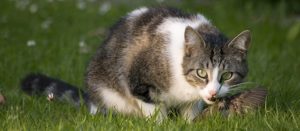In the context of the recent announcement of Ruisseau Jackson’s emblematic bird, we were informed of the following article in the Morin-Heights News Bulletin. Some citizens are concerned for Ruisseau Jackson’s birds!
Dr. Lena Measures, the article’s author, is a wildlife biologist, member of Ruisseau Jackson presented her findings at the RJANP’s General Assembly.
With permission, we reproduce her article from March, 1st 2012. For those interested we can provide you with copies of the full study.
The domestic cat – an exotic invasive species
The International Union for the Conservation of Nature (IUCN) classified the domestic cat, Felis silvestris catus, as an exotic invasive or alien species, among the 100 worst in the world. Descended from African wildcats, and domesticated in Egypt over 9,000 years ago, domestic cats fall into 2 categories. “Housecats” are kept indoors 24/7, “outdoor or free-roaming cats” are allowed outdoors but both may become “feral” or wild if lost or abandoned by their owners. A survey made by Léger Marketing in 2008 showed that 29% of Quebec households have a cat, with an average of 1.6 cats per owner, thus an estimated 1.45 million housecats with feral cats numbering perhaps 435,000 to 725,000.
Domestic cats are predators, killing prey such as small mammals, birds, especially ground nesting or feeding birds, as well as insects, amphibians and reptiles. Anyone owning a free-roaming cat has likely observed their cat bringing home dead (occasionally live) mice or birds. These wellfed cats often do not eat their prey but are “recreational” predators. Studies in the United Kingdom show that free-roaming cats kill an estimated 52 to 63 million mammals, 25 to 29 million birds and 4 to 6 million amphibians and reptiles each year, with 30% of bird mortality attributed to cats. These may actually be under-estimates as one U.S. study showed that faeces in litter boxes contained 10% bird remains; owners had no knowledge that their freeroaming cat was killing and eating birds before returning home!
Cats have caused extinction of several native small mammal species, some 30 species of birds, threaten species at risk or contribute to declines in populations (Eastern Bluebird, and Ruby-throated Hummingbird are examples). Free-roaming and feral cats may also compete with native predators such as mink, raccoons, skunks, foxes and raptors. Cats (feral and freeroaming) comprised 25% of captures in a recent rabies raccoon/skunk study by Quebec Ministry of Natural Resources and Wildlife (MNRF).
It cannot be overstated that free-roaming and feral cats have significant effects on public and wildlife health as transmitters of disease, the most well-known being rabies and toxoplasmosis. More cats than dogs have been infected with rabies since 1980 and cats are the only known final host of Toxoplasma gondii , a parasite that can cause foetal abnormalities and abortions in pregnant women. Disposal of infected cat faeces is problematic.
Free-roaming dogs may attack wildlife, domestic animals and humans and society has strict laws, licensing and leash regulations. Most dogs are vaccinated against rabies and responsible owners pick up after their dogs, eliminating faeces as a source of disease. Cats are rarely licensed nor regulations enforced should they wander off property.
Being small and secretive by nature, cats tend to keep to areas providing cover and are rarely seen, thus making enforcement difficult particularly in suburban or rural areas. In Quebec close to 40% of cats brought to animal shelters are not housecats.
Keeping cats indoors prolongs their lives and ensures their health and welfare. Free-roaming and feral cats must contend with automobile traffic, predators such as coyotes, wolves, fishers, foxes, raptors, disease, and weather. Feral cats often live less than one year, frequently starving or freezing in cold climates. In the Laurentians, numerous cats have been killed by predators such as fishers. Responsible caring owners keep cats indoors 24/7 or provide a secure outdoor enclosure, sterilize them to avoid unwanted litters, provide scratch posts, perhaps another cat playmate, annual vaccinations, identify them with a micro-chip and collar with name, address and phone number should an escape occur and, reduce the spread of disease by disposing of cat faeces and litter in the garbage.


